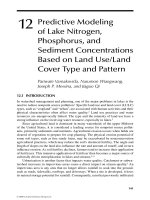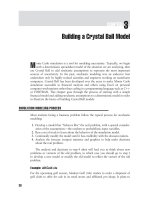Managerial decision modeling with spreadsheets by stair render chapter 12
Bạn đang xem bản rút gọn của tài liệu. Xem và tải ngay bản đầy đủ của tài liệu tại đây (806.26 KB, 51 trang )
Chapter 12:
Inventory Control Models
© 2007 Pearson Education
Inventory
• Any stored resource used to satisfy a
current or future need (raw materials,
work-in-process, finished goods, etc.)
• Represents as much as 50% of invested
capitol at some companies
• Excessive inventory levels are costly
• Insufficient inventory levels lead to
stockouts
Inventory Planning and Control
For maintaining the right balance between high
and low inventory to minimize cost
Main Uses of Inventory
1.
2.
3.
4.
5.
The decoupling function
Storing resources
Irregular supply and demand
Quantity discounts
Avoiding stockouts and shortages
Inventory Control Decisions
Objective: Minimize total inventory cost
Decisions:
• How much to order?
• When to order?
Components of Total Cost
1.
2.
3.
4.
5.
Cost of items
Cost of ordering
Cost of carrying or holding inventory
Cost of stockouts
Cost of safety stock (extra inventory held
to help avoid stockouts)
Economic Order Quantity (EOQ):
Determining How Much to Order
• One of the oldest and most well known
inventory control techniques
• Easy to use
• Based on a number of assumptions
Assumptions of the EOQ Model
1.
2.
3.
4.
5.
Demand is known and constant
Lead time is known and constant
Receipt of inventory is instantaneous
Quantity discounts are not available
Variable costs are limited to: ordering
cost and carrying (or holding) cost
6. If orders are placed at the right time,
stockouts can be avoided
Inventory Level Over Time
Based on EOQ Assumptions
Minimizing EOQ Model Costs
• Only ordering and carrying costs need to
be minimized (all other costs are assumed
constant)
• As Q (order quantity) increases:
– Carry cost increases
– Ordering cost decreases (since the
number of orders per year decreases)
EOQ Model Total Cost
At optimal order quantity (Q*):
Carrying cost = Ordering cost
Finding the Optimal Order Quantity
Parameters:
Q* = Optimal order quantity (the EOQ)
D = Annual demand
Co = Ordering cost per order
Ch = Carrying (or holding) cost per unit per yr
P = Purchase cost per unit
Two Methods for Carrying Cost
Carry cost (Ch) can be expressed either:
1. As a fixed cost, such as
Ch = $0.50 per unit per year
2. As a percentage of the item’s purchase
cost (P)
Ch = I x P
I = a percentage of the purchase cost
EOQ Total Cost
Total ordering cost = (D/Q) x Co
Total carrying cost = (Q/2) x Ch
Total purchase cost = P x D
= Total cost
Note:
• (Q/2) is the average inventory level
• Purchase cost does not depend on Q
Finding Q*
Recall that at the optimal order quantity (Q*):
Carry cost = Ordering cost
(D/Q*) x Co = (Q*/2) x Ch
Rearranging to solve for Q*:
Q* = ( 2 DCo / Ch )
EOQ Example: Sumco Pump Co.
Buys pump housing from a manufacturer
and sells to retailers
D = 1000 pumps annually
Co = $10 per order
Ch = $0.50 per pump per year
P = $5
Q* = ?
Using ExcelModules for Inventory
• Worksheet for inventory models in
ExcelModules are color coded
– Input cells are yellow
– Output cells are green
• Select “Inventory Models” from the
ExcelModules menu, then select “EOQ”
Go to file 12-2.xls
Average Inventory Value
After Q* is found we can calculate the
average value of inventory on hand
Average inventory value = P x (Q*/2)
Calculating Ordering and
Carrying Costs for a Given Q
• Sometimes Co and Ch are difficult to
estimate
• We can use the EOQ formula to calculate
the value of Co or Ch that would make a
given Q optimal:
Co = Q2 x Ch/(2D)
Ch = 2DCo/Q2
Sensitivity of the EOQ Formula
• The EOQ formula assumes all inputs are
know with certainty
• In reality these values are often estimates
• Determining the effect of input value
changes on Q* is called sensitivity
analysis
Sensitivity Analysis for Sumco
• Suppose Co = $15 (instead of $10), which
is a 50% increase
• Assume all other values are unchanged
• The new Q* = 245 (instead of 200), which
is a 22.5% increase
• This shows the nonlinear nature of the
formula
Reorder Point:
Determining When to Order
• After Q* is determined, the second
decision is when to order
• Orders must usually be placed before
inventory reaches 0 due to order lead time
• Lead time is the time from placing the
order until it is received
• The reorder point (ROP) depends on the
lead time (L)
Reorder Point (ROP)
ROP = d x L
Sumco Example Revisited
• Assume lead time, L = 3 business days
• Assume 250 business days per year
• Then daily demand,
d = 1000 pumps/250 days = 4 pumps per day
ROP = (4 pumps per day) x (3 days)
= 12 pumps
Go to file 12-3.xls
Economic Production Quantity:
Determining How Much to Produce
• The EOQ model assumes inventory
arrives instantaneously
• In many cases inventory arrives gradually
• The economic production quantity
(EPQ) model assumes inventory is being
produced at a rate of p units per day
• There is a setup cost each time
production begins









